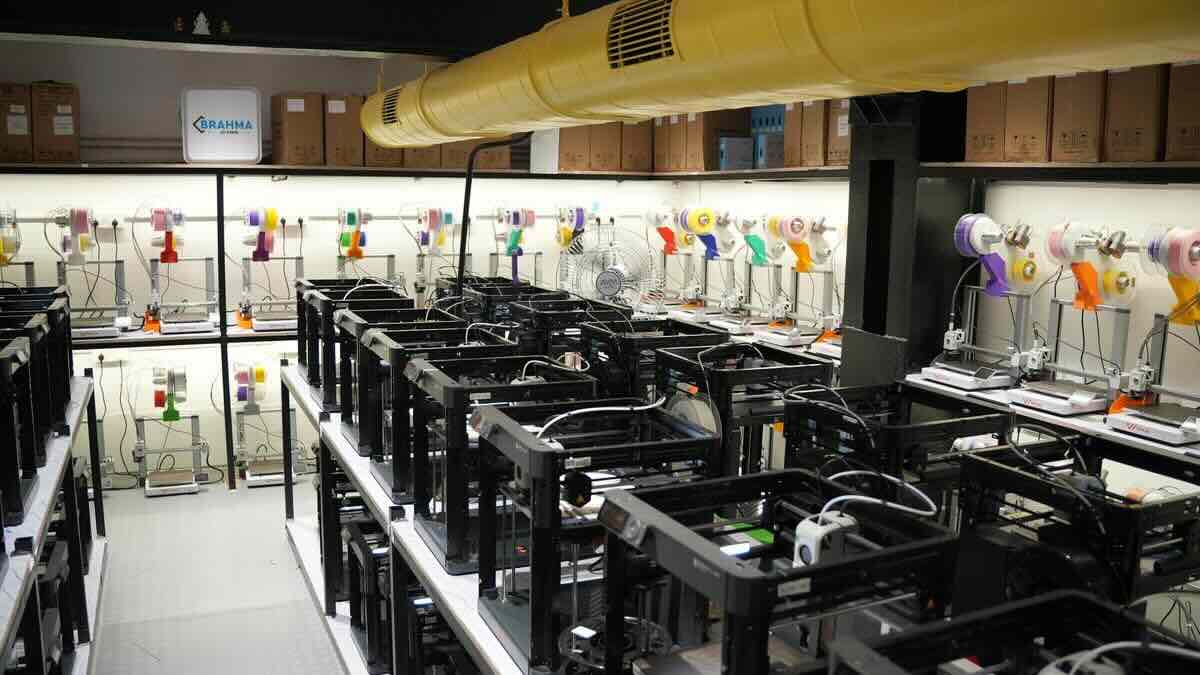Deltasys E-Forming, an industrial 3D printing solutions manufacturer, has introduced a first-of-its-kind tabletop concrete 3D printer specifically designed for educational institutions and research laboratories to advance material research. This new system addresses the prevalent barriers of high investment costs, space requirements, and infrastructure needs that have kept concrete 3D printing technology outside the reach of most academic institutions.
The compact, research-oriented tabletop R&D concrete 3D printer enables students and researchers to gain hands-on experience with additive construction materials at a fraction of the cost of industrial-scale systems. This development can democratise access to advanced construction technologies across educational environments of varying resource levels.
Tabletop Concrete 3D Printer
Assembling and operating the tabletop concrete 3D printer/Source: Deltasys E-Forming
The new tabletop R&D concrete 3D printer from Deltasys E-Forming offers a build volume of 600mm x 600mm x 600mm, sufficient for meaningful research while maintaining a footprint compatible with standard laboratory spaces. This careful balance between capability and practicality makes the system particularly suitable for educational environments where space and budgets are typically constrained. This obviously also brings down the cost for the institute making the purchase thereby enabling more colleges to access this technology.
A key feature of the printer is its integrated material mixer and precise dosing system, which allows for the extrusion of various cementitious mortars and paste-based materials. This functionality enables direct experimentation with different mix designs, supporting research in concrete rheology, thixotropy, buildability, and strength testing—all essential areas for advancing the science of 3D printed construction.
The system includes several advanced features designed specifically for research applications:
- A separate control unit housing all driving systems, controllers, and safety components, featuring an 18-inch screen and computer interface
- An extrusion head with 6-7 kg material loading capacity, powered by a high-torque hybrid servo motor and gearbox for processing aggregated materials
- A robust carbon steel gantry structure with precision CNC-machined surfaces for guideway and rack mounting
- A pan mixer with minimum four blades and 10 kg capacity for material preparation
“Our aim was simple—build a lab-friendly concrete 3D printer that empowers students and researchers to experiment, innovate, and contribute to the future of sustainable construction.”
– Virendra Kadam, CEO and Founder of Deltasys E-Forming
This vision has guided the development of a system capable of operating continuously for up to two weeks, providing the reliability needed for extended research projects.
Designed for Educational Environments

The tabletop R&D concrete 3D printer has been engineered with the specific needs of educational institutions in mind. Its cost-effective design makes advanced 3D printing capabilities accessible even to tier-2 and tier-3 colleges that typically operate with limited resources for technological investment.
The system supports direct import of CAD models, allowing students to move seamlessly from digital design to physical prototyping. This workflow mirrors industry practices, providing valuable hands-on experience with the tools and techniques that are increasingly central to modern construction methodologies.
Beyond its research applications, the printer serves as an effective teaching aid, giving students practical exposure to the additive manufacturing technologies that are reshaping construction practices globally.
The printer can process a wide range of materials, including:
- Any cementitious systems with appropriate pumpability, extrudability, and printability
- Concrete, mortar, clay, or ceramic paste
- Materials with aggregates up to 2mm in size
- Common reinforcing fibers including steel, polypropylene, glass fiber reinforced (GFR), and carbon fiber reinforced (CFR)
This material flexibility enables diverse research applications, from basic construction material testing to advanced composite development.
Advancing Material Research
Construction 3D printers are largely used in institutes to research construction materials and methodologies and this smaller printer can certainly aid in advancing the material innovation. As the construction sector increasingly focuses on sustainability, automation, and digital fabrication, material development has become a critical area for advancement.
The printer enables even smaller institutions to actively participate in this innovation ecosystem through materials research, sustainability studies, and prototype testing within their own facilities. This capability opens new avenues for collaboration between academia and industry, potentially accelerating the development of novel construction materials and techniques.
For civil engineering, architecture, and materials science departments, the tabletop R&D concrete 3D printer offers unprecedented opportunities to integrate cutting-edge construction technologies into their curricula and research programs.
The system’s adoption by Southern Illinois University demonstrates its value to international research institutions and its potential to support advanced studies in sustainable construction materials and techniques. This global reach suggests growing recognition of the importance of hands-on experience with concrete 3D printing technology in contemporary construction education.
Future-Ready Engineering Education
By making concrete 3D printing technology more accessible to educational institutions, the tabletop R&D concrete 3D printer can be perfect for preparing the next generation of construction professionals for an industry increasingly defined by automation, digital tools, and advanced materials.
The system comes with comprehensive support, including:
- A full one-year warranty on all components (excluding normal wear and tear)
- Complete operation and working manuals
- Two days of on-site training provided by Deltasys E-Forming engineers
- Pre-delivery testing using compatible 3D printing materials
These support features ensure that institutions can quickly integrate the technology into their educational and research programs with minimal disruption, maximising the system’s educational value from day one.
As construction continues its digital transformation, educational access to tools like the tabletop R&D concrete 3D printer will be essential in building the workforce and knowledge base needed to fully realise the potential of these new approaches.
About Manufactur3D: Manufactur3D is an online magazine on 3D Printing. Visit our Indian Scenario page for more updates on 3D Printing News from India. To stay up-to-date about the latest happenings in the 3D printing world, like us on Facebook or follow us on LinkedIn and Twitter.











